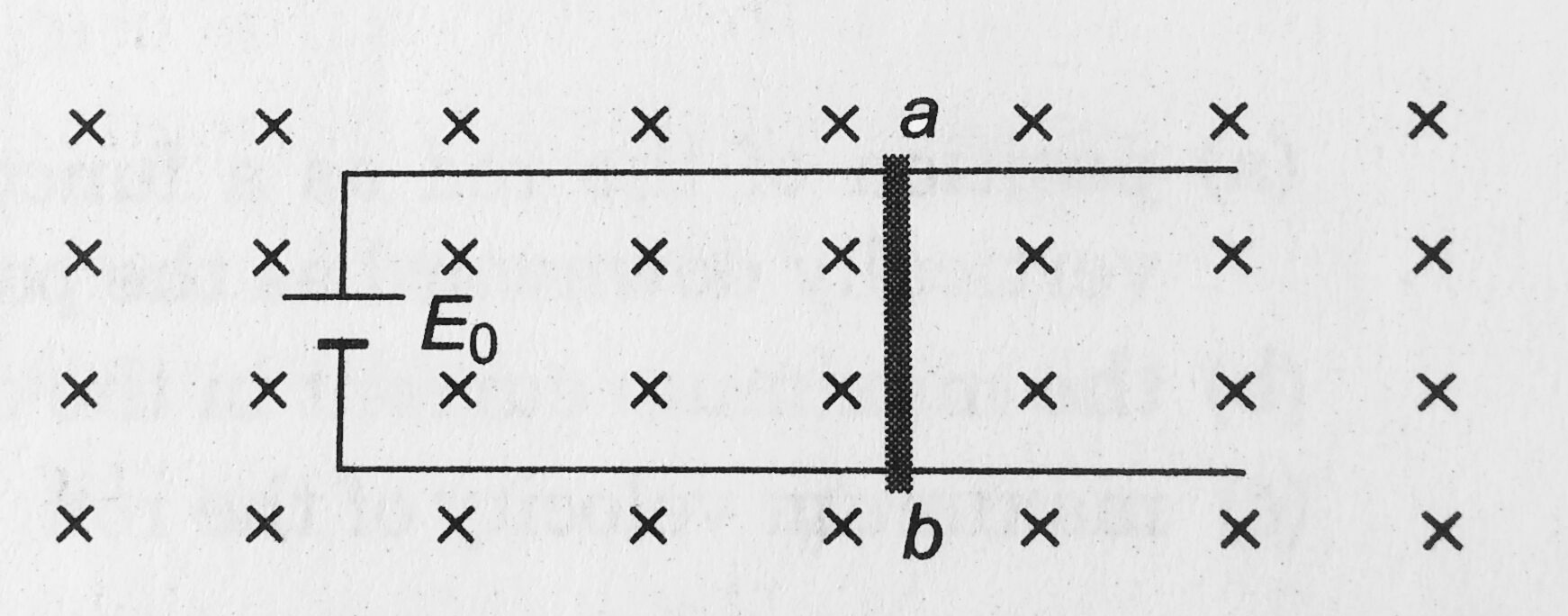A metallic rod of mass m and resistance R is sliding over the 2 conducting frictionless rails as shown in Fig. An infinitely long wire carries a current I0. The distance of the rails from the wire are b and a respectively.

Find the value of F if the rod slides with constant velocity
μ0I02πR[E+μ0I02πv01n∣∣∣ba∣∣∣]1n(ba)
μ0I0πR[E−μ0I02πv01n∣∣∣ba∣∣∣]1n(ba)
μ0I02πR[E−μ0I02πv01n∣∣∣ba∣∣∣]1n(ba)
None of these
The correct Answer is:C
(a) Magnetic flux linked with the differential area element shown in fig.

Net flux = ∮dϕ=∫baμ0i2πyxdy=μ0i2π1n∣∣∣ba∣∣∣
emf(e)=∣∣∣−dϕdt∣∣∣=μ0i2vv01n∣∣∣ba∣∣∣
[dxdt=v0]
emf can be calculated using motional emf method, emf developed due to motion of the conductor has an opposite secse to the emf of the cell
therefore, i=EeR=1R{E−(μ0I0v02π1n∣∣∣ba∣∣∣}
(b) F=∫dF=∫×→B
=∫[1R{E−(μ0I0v02π1n∣∣∣ba∣∣∣}⋅dy⋅μ0I02πy]
F=(μ0I02πv01m∣∣∣ba∣∣∣]1n(ba).
Topper's Solved these Questions
- BOOK - CENGAGE PHYSICS ENGLISHCHAPTER - MISCELLANEOUS VOLUME 5EXERCISE - Integer12videos
MISCELLANEOUS VOLUME 5
- BOOK - CENGAGE PHYSICS ENGLISHCHAPTER - MISCELLANEOUS VOLUME 5EXERCISE - Multiple Correct34videos
MISCELLANEOUS VOLUME 5
- BOOK - CENGAGE PHYSICS ENGLISHCHAPTER - MISCELLANEOUS VOLUME 3EXERCISE - True and False3videos
MISCELLANEOUS VOLUME 3
- BOOK - CENGAGE PHYSICS ENGLISHCHAPTER - NUCLEAR PHYSICSEXERCISE - ddp.5.514videos
NUCLEAR PHYSICS
Similar Questions
A metallic rod of mass m and resistance R is sliding over the 2 conducting frictionless rails as shown in Fig. An infinitely long wire carries a current I0. The distance of the rails from the wire are b and a respectively.

Find the value of current in the circuit if the rod slides with constant velocity v0View Solutiona rectangular loop, as shown in Fig. 3.66, moves away from an infinitely long wire carrying a current I. Find the emf induced in the rectangualr loop.
 View Solution
View Solutiona rectangular loop, as shown in Fig. 3.66, moves away from an infinitely long wire carrying a current I. Find the emf induced in the rectangualr loop.
 View Solution
View SolutionA copper rod moves with a constant angular velocity ω about a long straight wire carrying a current I. If the ends of the rod from the wire are at distances a and b, then the e.m.f induced in the rod is
 View Solution
View SolutionA metal bar AB can slide on two parallel thick metallic rails separated by a distance l. A resistance R and an inductance L are connected to the rails as shown in the figure. A long straight wire carrying a constant current I0 is placed in the plane of the rails and perpendicular to them as shown. The bar AB is held at rest at a distance x0 from the long wire. At t=0, it is made to slide on the rails away from wire. Answer the following questions.
(a) Find a relation among i,didtanddϕdt, where i is the current in the circuit and ϕ is the flux of the megnetic field due to the long wire through the circuit.
(b) It is observed that at time t=T, the metal bar AB si at a distance of 2x0 from the long wire and the resistance R carries a current (i1). Obtain an expression for the net charge that has flown through riesistance R form t=0 to t=T.
(c) THe bar is suddenly stopped at time T. THe current through resistance R is found to be i14 at time 2T. Find the value of LR in terms of hte other given quantities.
 View Solution
View SolutionA conducting circular loop of radius a and resistance per unit length R is moving with a constant velocity v0 , parallel to an infinite conducting wire carrying current i0. A conducting rod of length 2a is approaching the centre of the loop with a constant velocity v02 along the direction 2 of the current. At the instant t=0, the rod comes in contact with the loop at A and starts sliding on the loop with the constant velocity. Neglecting the resistance of the rod and the self-inductance of the circuit, find the following when the rod slides on the loop.

(a) The current through the rod when it is at a distance of (a2) from the point A of the loop.
(b) Force required to maintain the velocity of the rod at that instant.View SolutionA wire of length L, mass m and carrying a current I is suspended from point O as shown, An another infinitely long wire carrying the same current I is at a distance L below the lower end of the wire. Given i=2A, L=1m and m=0.1kg (In 2=0.693)

What want to keep the suspended wire stationary by palcing a third inifinitely long wire carrying an upward current. Then this wire should be placedView SolutionA rod of mass m and resistance R slides on frictionless and resistance less rails at distance l apart, that include a source of emf E0 (see figure). The rod is initially at rest. Find the expression for the
a. Velocity of the rod v(t).
b. current in the loop i(t).
 View Solution
View SolutionFigure shows a wire of resistance R sliding on two parallel, conducting fixed thick rails placed at a separation l. A magnetic fild B exist in a direction perpendicular to the plane of the rails. The wire is moving with a constant velocity v. Find current through the wire
 View Solution
View SolutionA wire of length l, mass m and resitance R slides without any friction down the parallel conducting rails of negligible resistance (Fig). The rails are connected to the wire so that the wire and the rails form a closed rectangular conducting loop. The plane of the rails makes an angle θ with the horizontal and a uniform vertical magnetic field of induction B exists throughout the region. Find the steady-state velocity of the wire
 View Solution
View Solution

